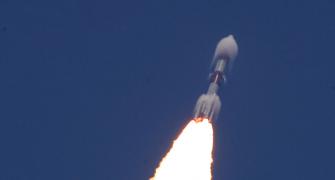Indian Space Research Organisaiton on Thursday released a 'selfie' and images of the Earth and the Moon -- the first of the images taken by the camera on-board Aditya-L1 solar mission spacecraft, which on reaching its intended orbit would begin sending as many as 1,440 images a day to the ground station for analysis.
'Aditya-L1, destined for the Sun-Earth L1 point, takes a selfie and images of the Earth and the Moon,' the Bengaluru-headquartered national space agency said on social media platform 'X'.
The images show VELC (Visible Emission Line Coronagraph) and SUIT (Solar Ultraviolet Imager) instruments as seen by the camera on-board Aditya-L1 on September 4, 2023.
ISRO also shared images of the Earth and Moon as seen by the camera.
VELC, the primary payload of Aditya L1, was built by Bengaluru-based Indian Institute of Astrophysics (IIA).
Inter-University Centre for Astronomy and Astrophysics (IUCAA), Pune, had developed the SUIT payload.
VELC is an internally occulted coronagraph, with 40 different optical elements (mirrors, gratings, etc) inside it that are aligned precisely.
The atmosphere of the Sun, the Corona, is what we see during a total solar eclipse. A coronagraph like the VELC is an instrument that cuts out the light from the disk of the Sun, and can thus image the much fainter corona at all times, IIA officials say.
VELC will be sending 1,440 images per day to the ground station for analysis on reaching the intended orbit, according to them.
VELC, 'the largest and technically most challenging' payload on Aditya-L1, was integrated, tested, and calibrated at the IIA's CREST (Centre for Research and Education in Science Technology) campus in Hoskote near here with substantial collaboration with ISRO.
ISRO successfully launched the Aditya-L1 using its trusted PSLV-C57 rocket on September 2.
The Aditya-L1 spacecraft carries a total of seven different payloads to study the Sun, four of which will observe the light from the Sun and the remaining three will measure in situ parameters of the plasma and magnetic fields.
Aditya-L1 will be placed in a halo orbit around the Lagrangian Point 1 (L1), which is 1.5 million km from Earth in the direction of the Sun.
It will revolve around the Sun with the same relative position and hence can see the Sun continuously.










